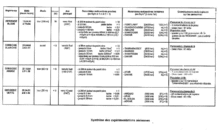Gerboise Bleue
Gerboise Bleue ("blue jerboa") was the name of the first French nuclear test. It was an atomic bomb detonated near Reggane, in the middle of the Algerian Sahara desert on 13 February 1960, during the Algerian War (1954–62).[1] General Pierre Marie Gallois was instrumental in the endeavour, and earned the nickname of père de la bombe A ("father of the A-bomb").
Gerboise is the French word for jerboa, a desert rodent found in the Sahara, while blue is the first color of the French tricolor flag. The second and third bombs were named respectively "white" (Gerboise Blanche) and "red" (Gerboise Rouge), the remaining colors of the flag.
The most powerful first test A-bomb
With Gerboise Bleue, France became the fourth nuclear power, after the United States, the USSR, and the United Kingdom. Gerboise Bleue was by far the largest first test bomb up to that date, larger than the American "Trinity" (20 kt), the Soviet "RDS-1" (22 kt), or the British "Hurricane" (25 kt). The yield was 70 kilotons, bigger than these three bombs put together. General De Gaulle stated:
| “ | Hurray for France! Since this morning, she is stronger and prouder.[2][3] | ” |
In comparison, Fat Man, the Nagasaki bomb, was 22 kilotons, one-third as powerful.
Only two other A-bombs tested in the Sahara facilities were more powerful: "Rubis" (<100 kt, 20 October 1963), and "Saphir" (<150 kt, 25 February 1965). Both were detonated underground at the Tan Afella facility.
All other French atomic-bomb tests, including Canopus, were carried out in French Polynesia from 1966 to 1996. The last bomb, Xouthos (<120 kt), was detonated on 27 January 1996.
As the atomic yield of a new bomb design cannot be precisely predicted, the French army planned an explosion between 60 and 70 kt. Gerboise Bleue was a total success, yielding the full designed power.[4]
Critics and international reactions
According to Lieutenant Colonel Warner D. Farr in a report to the USAF Counterproliferation Center "Progress in nuclear science and technology in France and Israel remained closely linked throughout the early fifties." Furthermore, according to Farr, "There were several Israeli observers at the French nuclear tests and the Israelis had 'unrestricted access to French nuclear test explosion data.'"[5]

Due to increasing criticism, France stopped its atmospheric tests in the desert, and conducted further underground tests months after Algerian independence in 1962 according to secret agreements with the FLN.
From February 1960 to April 1961, France tested a limited number of atmospheric bombs in Reggane facility's C.S.E.M. (Centre Saharien d'Expérimentations Militaires, or "Saharan Center for Military Experiments"): the four Gerboise bombs. Three of them were only engins de secours ("emergency devices"), with yields deliberately reduced to less than 5 kilotons. With the underground tests the sequence designation was changed to jewel names, starting in November 1961 with "Agathe" (agate; <20 kt). On 1 May 1962, during the second test, the "Beryl incident" (incident de Béryl) occurred, which was declassified many years later.
Five months after the last Gerboise A-bomb, the Soviet Union responded by breaking its atmospheric tests moratorium, settled de facto since late 1958 with the United States and the United Kingdom. The USSR conducted many improvement tests, starting in September 1961 with a series of 136 large H-bombs. The series included the most powerful bomb ever tested, the 50-megaton (50,000 kt) "Tsar Bomba", which was detonated over Novaya Zemlya.
Following the USSR, the United States reactivated its own atmospheric test program with a series of 40 explosions from April 1962 to November 1962. This series included two powerful H-bombs topping 7.45 Mt and 8.3 Mt.[1]
China also launched its own nuclear program, resulting in the A-bomb "596" (22 kt) tested on 16 October 1964, and the H-bomb Test No. 6 (3.3 Mt), tested 17 June 1967.
In 1968, France detonated its first thermonuclear weapon, Canopus (2.6Mt), at the new facility at Fangataufa, a desert atoll in French Polynesia.
Programme

- 13 February 1960: Gerboise Bleue ("blue jerboa"): 70 kt
- 1 April 1960: Gerboise Blanche ("white jerboa"): <5 kt
- 27 December 1960: Gerboise Rouge ("red jerboa"): <5 kt
- 25 April 1961: Gerboise Verte ("green jerboa"): <1 kt
Gerboise Rouge was followed by a joint exercise, in which infantry, helicopters and armour reconnoitered the contaminated area.[6]
Gerboise Verte was intended to yield between 6 and 18 kilotonnes, but effectively yielded less than 1.[6] Like Gerboise Rouge, it was followed by a joint exercise in the contaminated area, codenamed Garigliano.[6] The test had been patched up hastily and fired prematurely because of the Algiers putsch, as it was feared that the nuclear bomb could fall in the hands of seditious elements.[7]
Specifics
- Time: 6:04 13 February 1960 (GMT)
- Location: Tanezrouft (near Reggane)
- Test Height and Type: Tower, 100 m
- Yield: 70 kt
See also
- Agathe (atomic test) (French underground A-bomb)
- Canopus (French H-bomb)
- Force de Frappe
- List of states with nuclear weapons
- Nuclear weapons and France
Notes
- 1 2 French Senate report #179: The first French tests in the Sahara
- ↑ Hourra pour la France ! Depuis ce matin, elle est plus forte et plus fière.
- ↑ Il y a cinquante ans, la France réalisait son premier essai nucléaire, Jean-Dominique Merchet, Libération, 13 February 2010
- 1 2 French Senate report
- ↑ Farr, Warner D (September 1999), The Third Temple's holy of holies: Israel's nuclear weapons, The Counterproliferation Papers, Future Warfare Series, 2, USAF Counterproliferation Center, Air War College, Air University, Maxwell Air Force Base, retrieved July 2, 2006
- 1 2 3 Essais nucléaires : Gerboise verte, la bombe et le scoop qui font plouf... (actualisé), Jean-Dominique Merchet, Libération
- ↑ Sahara: les cobayes de «Gerboise verte», Le Nouvel Observateur, Vincent Jauvert, 5 February 1998
External links
- French Assembly report n°3571
- Les premiers essais français au Sahara (1960-1966) (fr)
- The failed atomic destiny of the French Algeria (fr)
Coordinates: 26°18′40″N 0°3′25″W / 26.31111°N 0.05694°W